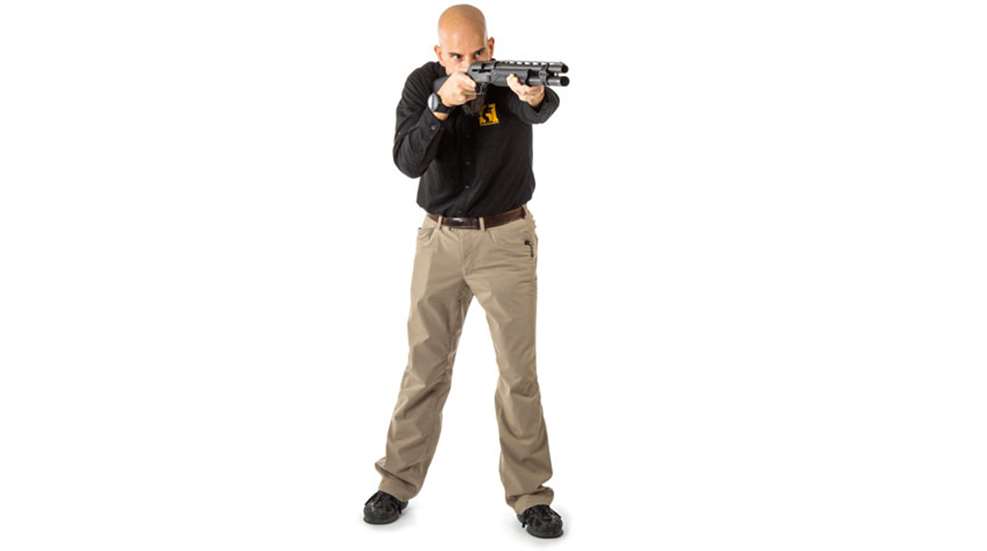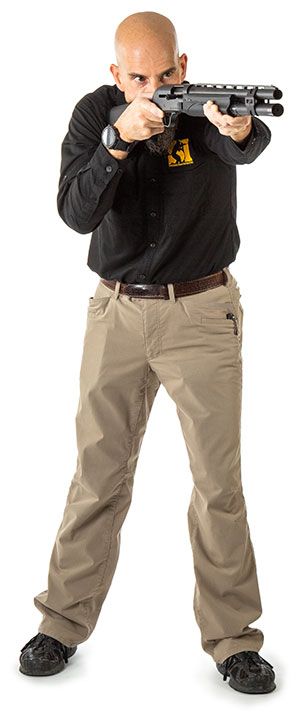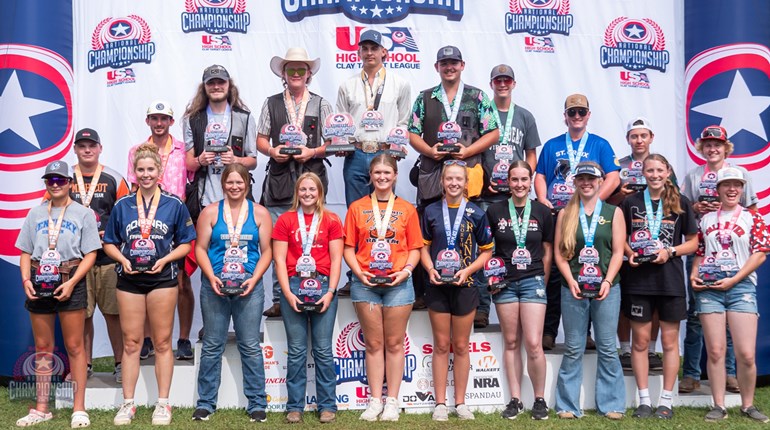
Traditional shotgunners have largely taken a tall, weight-forward stance to swing the shotgun fluidly and to combat the gun’s tremendous recoil. In days past, nearly every American who was brought up in the hunting and shooting lifestyle learned to shoot a shotgun this way to better hit moving targets such as quail, clay pigeons or rabbits. This column, however, is dedicated to defensive use of the shotgun, and plenty of today’s defensive-minded instructors teach a much more squared, athletic stance that facilitates movement. Simplified, squared and squatty is better for moving, while straight and bladed is better for shooting. Somewhere therein lies a balance of both. So, what’s best for you? Keep reading.
Before getting into the various stance styles, let’s break them down into their major parts: Foot position, torso rotation and weight distribution.
Foot Position: The squarer the stance to the target (i.e., all toes pointed directly at the target) the easier it is to walk, run and move suddenly in any direction. The more the knees are bent, the better the balance. Feet slightly staggered, shoulder-width apart promotes agility and recoil mitigation.
Torso rotation: A “bladed” stance means the weak-side shoulder is closer to the target than the strong-side shoulder. It promotes instinctive shooting and mitigates recoil, but it also lessens body armor’s effectiveness and peripheral vision to the weak side. Bent at the waist toward the target indicates an aggressive posture suited for maximum recoil control.
Weight Distribution: More weight placed over the front foot (for staggered stances) or over the toes (for squared stances) will result in greater recoil mitigation and faster, more accurate follow-up shots—but will also slow lateral movement.
 Shooting Styles and Stances
Shooting Styles and Stances
Wingshooting
In general, dedicated shotgun-sports shooters (trap, skeet and sporting clays) take on a feet-close-together, straight-legged, weak-leg-forward stance, with the toes pointing 45 degrees to the target, 95 percent of the weight over the front foot. Such a stance allows wingshooters to swing the shotgun by more-or-less pirouetting on the front foot while using the toe of the rear foot as a rudder for balance. This tall, elegant stance is deceiving, because while it doesn’t look aggressive, most of the shooter’s body weight can be thrust into the shotgun at the shot, thereby counteracting the forces of recoil. However, there are obvious reasons why this stance isn’t the most practical for home defenders.
First, the level, concrete square of a skeet field poses no obstacles that must be navigated or uneven surfaces to disrupt balance. Secondly, clay target shooters must never move in any direction. Lastly, recoil from trap and skeet loads, combined with relatively heavy guns, allow such a gentlemanly stance, but one that’s impractical for home defenders where dynamic movement is imperative.
Close-Quarters Carbine
Some military and law-enforcement personnel are trained to shoot a shotgun much like they do a carbine, which is to say their feet are square to the target, shoulder-width apart, toes pointed toward the target, torso square to the target but leaning over slightly so the weight is divided 50/50 over the balls of each foot. This allows operators to maximize peripheral vision and to walk and move in any direction. The squared-chest orientation maximizes body armor’s protection. For most civilian home defenders, however, this stance can be disastrous.
First, most home defenders do not wear body armor. Second, a shotgun loaded with 00 buck has up to 10 times the recoil of a 5.56 NATO carbine, so recoil is a real issue. For all but the biggest, brutish shooters, three shots in succession from a square stance can rock a shooter so far backward that they may fall. (Try it for yourself.) I believe this stance was dogmatically taught to some military types to conform to other curriculum being taught at the time, such as dynamic entry, where moving smoothly and facing the enemy was paramount. These days, however, I see more shotgun-savvy military and law-enforcement shooters adopting a slightly more staggered, hybrid stance of 55/45 (front foot/rear foot) weight distribution. Even so, they keep the torso square to the target as much as possible.
Hunting
Bird hunters often institute an 80-percent-weight-forward stance with the knees slightly bent and the feet spaced slightly farther apart than clay shooters because in the field, terrain is often uneven and birds are unpredictable. Still, this stance isn’t practical for most home defenders, where moving while shooting may save your life.
Plenty of today’s defensive-minded instructors teach a much more squared, athletic stance that facilitates movement. Simplified, squared and squatty is better for moving, while straight and bladed is better for shooting.
3-Gun
The preferred shotgun stance of professional 3-gun shooters is offense-oriented. Most of these shooters assume a staggered stance where one foot is in front of the other, knees slightly bent, feet shoulder-width apart, torso bladed 40 degrees and bent forward at the waist so that 70 percent of their weight is forward. From this position, they can run, stop and fire multiple times while absorbing recoil and mitigating muzzle flip so they can get the maximum number of shots on target in the least amount of time.
However, there are a couple of significant differences between pro 3-gunners and home defenders: First, 3-gunners don’t have to consider retreating. This enables them to commit more to a weight-forward stance geared for shooting quickly, instinctively and accurately. Additionally, 3-gunners must focus on shooting 10 to 15 shots as fast as possible, mandating their weight be aggressively forward. But, this high-volume “running and gunning” is unrealistic for home defenders.
Home Defense
So then, the best stance for most home defenders—one that promotes a compromise between fast and accurate shooting while maintaining great balance and mobility—is one where the stance is slightly staggered, with the toe of the right foot in line with the heel of the left, feet slightly more than shoulder-width apart, toes pointing 30-degrees to the target, knees bent, chest slightly bladed 25 degrees and the torso bent forward at the waist so 65 percent of the weight is over the balls of the feet. However, during the actual shot, you may find that more weight should be shifted (shotgunners call it “throwing your weight”) forward as much as 80 percent to counteract recoil before being shifted back as soon as the recoil impulse is finished.
But, people, circumstances and shotguns are all a little different. The most important thing is to find and develop a shotgun stance that works best for you. Tactical guys say squared, wingshooters say 90-percent-weight forward, 3-gunners say bladed; I say use what works for you.






































